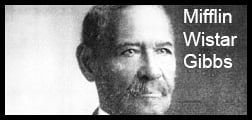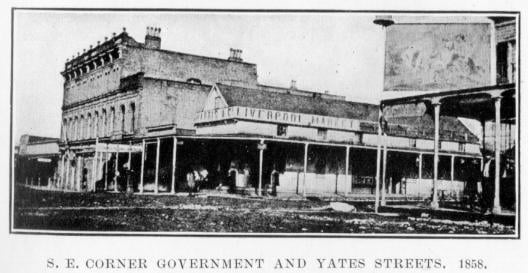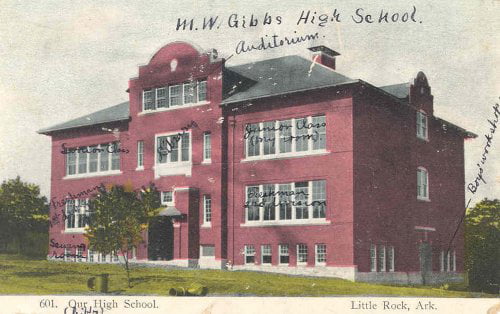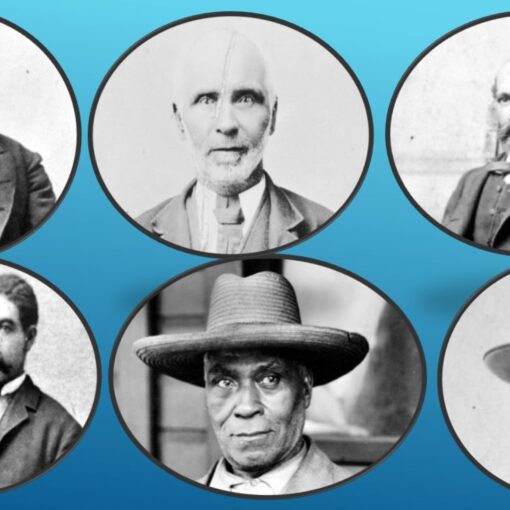The Government of Canada is proud to honor a man who worked tirelessly for the local Black Community as a politician, businessman, and defender of human rights ...
His story...

Mifflin Wistar Gibbs was born in Philadelphia, April 17, 1823 to Jonathan C. and Maria Gibbs. Gibbs father, a minister in the Wesleyan Church, died suddenly when Mifflin was 8. He writes “… leaving my mother with four small children … unable to remain long at school, I was ‘put out’ to hold and drive a doctor’s horse at three dollars a month and was engaged in similar employment until I reached sixteen ..”
At age 16, he began learning the trade of carpentry, at the same time he spent every night reading, determined to acquire the fundamentals of an education. Gibbs also joined the Philadelphia Library Company, a group of black men who met to discuss the social and legal issues facing Blacks in the U.S. It was at this time that Gibbs met Frederick Douglass. Gibbs was already active in the abolitionist movement and Douglass invited Gibbs to tour with him on his anti-slavery lecture circuit.
While on these tours with Douglass, Gibbs heard about the California Gold Rush and he headed to California. However, it was not mining that Gibbs pursued, instead he went into business with a partner, Peter Lester. Their advertisement in a San Francisco paper read, “Lester & Gibbs, Importers of Fine Boots and Shoes from Philadelphia, London and Paris.” Gibbs also helped to establish and publish “The Mirror of the Times”, a periodical advocating equal rights for all Americans.
Though Gibbs and Lester prospered, conditions in California were difficult for Blacks. For example, a Black person could not testify in court in cases involving a White person; there were no schools for Blacks above the elementary level; and Black students were barred from attending White schools. Also, even though Blacks paid business taxes, known as the “poll tax”, they were not allowed to vote.
The Methodist Episcopal Zion Church, which Gibbs attended, was actively seeking solutions to help the Black community; and it was at these meetings that plans were discussed for Blacks to leave California.
plans were discussed for Blacks to leave California.
Gibbs listened to the invitation and reports from Victoria and came to a decision - he would join the emigration of 1858. In his autobiography, “Shadow and Light,” he writes: “In June of that year, with a large invoice of miners’ outfits - flour, blankets, picks, shovels, etc., I took passage on the steamship ‘Republic’ for Victoria.”

Gibbs was not interested in settling in the mining camps of the Fraser River. He chose instead to utilize his knowledge and skills in an area with which he was familiar - merchandising. He wrote “On my arrival my goods were sold at great advance on cost, an order for more sent by returning steamer.”
Real Estate was also of interest to Gibbs. Shortly after his arrival he purchased a one-story building near today’s corner of Government and Yates Streets. Gibbs outlined the situation with admirable clarity in a letter published by the San Francisco Daily Evening Bulletin on June 23, 1858. Writing to “Friend L” he says: “You will now see that I have arrived at my point of destination. I came, however, rather late to make the most advantageous investments. The country is certainly a beautiful one - a country good enough for me - and I am sorry to be so far behind. If either of us had arrived here two months ago, worth $1,000, we could have been worth $10,000 today.”
After deciding to make Victoria his home, he returned to the United States in 1859 and married Maria Anne Alexander, a graduate of Oberlin College in Ohio. Though they lived comfortably, employed servants, and had five children during their years in Victoria, Mrs. Gibbs had never been accepted by the women who considered themselves the elite in society. She returned to the United States in 1867 with their 5 children.
Politics and Economics: Gibbs took advantage of opportunities open to him as a British subject; opportunities that were denied him in United States. In November 1866 he was elected to the Victoria City Council, representing the James Bay District, where he had purchased land and built a house. He supported Confederation and was the delegate for Salt Spring Island at the Yale Convention in 1868, a gathering called to debate the question of B.C. joining the Federation of Canada or going for annexation to the United States. Gibbs was firmly on the side of staying with Canada; and helped to frame the terms by which British Columbia entered the Canadian confederation.
Gibbs was both a director and a major shareholder in the Queen Charlotte Coal Company. In 1869, he resigned his directorship to tender a bid to construct a wharf and tramway for the company at Queen Charlotte Island. His bid was accepted, so he took a leave of absence from the City Council. He expected to be back in Victoria for the opening of “Victoria House,” the largest and most modern mercantile building in the colony, which was under construction on one of his downtown lots. Instead, he stayed longer, resulting in the loss of his seat on City Council.
In 1870 Gibbs liquidated all his assets except Victoria House and returned to the United States to join his family.
Mifflin Gibbs was successful in British Columbia; he prospered in business, he read law in the office of D.B. Ring, and was a respected political leader. In the US, after taking a refresher course in law, he became a municipally elected judge in Little Rock, Arkansas. He was made State Registrar of Lands by President Harrison, and at the age of 75 was appointed United States Consul to Madagascar, where he served for three years until 1901.
In 1902 he wrote and self-published his autobiography “Shadow and Light”.
In 1907 he visited Victoria and was received as a distinguished former resident.
He died July 11, 1915, aged 92. A high school in Little Rock, Arkansas, was named in his honour.
 Canadian Recognition:
Canadian Recognition:

May 4, 2019. Dr. Verna Gibbs, Great, great grandniece, unveiled this plaque with Mayor Lisa Helps in a ceremony held at Irving Park. Dr. Gibbs travelled from San Francisco to attend this event. Why Irving Park? Gibbs’ home and estate was situated at this location and is the centre of the James Bay neighborhood that Gibbs represented as a Victoria councillor. The plaque was installed in January 2019. The plaque reads “After helping lead the exodus of 800 Black residents from San Francisco in 1858, Gibbs became the recognized leader of their community on Vancouver Island. He strove to make these newcomers a force in colonial politics and, as a member of Victoria City Council, he became the first Black person to hold elected office in British Columbia. This innovative entrepreneur, who invested in mining and trade, also encouraged the integration of Black settlers and advocated for their rights. Though he returned to the United States in 1870, Gibbs remains a revered historical figure in the province’s African-Canadian community.“ The plaque was presented to the Society and the City of Victoria on February 19, 2017 by Liberal MP John Aldag, Richard Wishart of Historic Sites and Monuments Canada. Dr. Yvonne Brown, EdD UBC was the lead researcher who submittted the documentation for this plaque.
May 6, 2018: A meeting room, in the sxʷeŋ’xʷəŋ taŋ’exw James Bay Library Branch has been named The Mifflin Wistar Gibbs Study Room. Gibbs was a resident of James Bay and their elected council representative for three years. The library is located diagonal to Irving Park where the Mifflin Gibbs Commemorative plaque is installed.
February 23, 2017: To mark Canada's 150th birthday, 150 noteworthy British Columbians named: Mifflin Gibbs - first black elected to public office in B.C.
February 19, 2017: Mifflin Wistar Gibbs was honored with a bronze plaque presented as part of B.C. Black History Month 2017 Heritage Day. . The plaque commemorates Gibbs as a person of national historic significance. The presentation ceremony was conducted and Lisa Helps, Mayor of Victoria. The construction, presentation ceremony and installation of this plaque is funded by the Government of Canada through Parks Canada and the Heritage and Monuments Board of Canada.
November 16, 2016: “Mifflin Wistar Gibbs Day” proclaimed by the City of Victoria in recognition of his election to Victoria City Council on November 16, 1866.
February 29, 2016: “Welcome Home Mifflin Gibbs” tribute to Gibbs performed by local actor Justin Carter at the Belfry Theatre as part of Black History Month 2016, sponsored by BCBHAS and GVPL.
August 4, 2009: Government of Canada recognizes the historical significance of Mifflin Wistar Gibbs. "Our government is proud to honor a man who worked tirelessly for the local Black Community as a politician, businessman, and defender of human rights". said Minister Prentice. "With today's commemoration, we take another step in bringing the national historic significance of Mifflin Wistar Gibbs to all Canadians".
Quick Facts
First Black B.C. politician
Birth: April 17, 1823, Philadelphia, Pennsylvania
Death: July 11, 1915, Little Rock, Arkansas
1902: Published auto biography "Shadow and Light"
Spouse: Maria Anne Alexander




